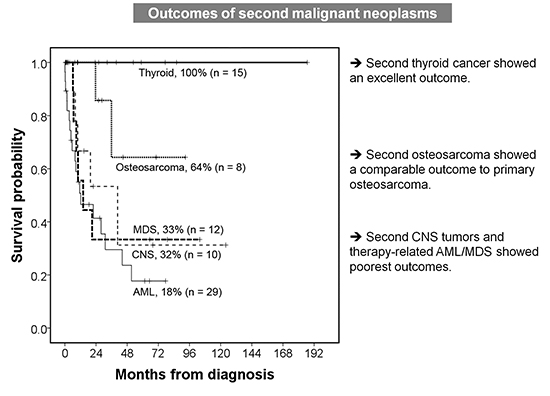1. Armstrong GT, Liu W, Leisenring W, Yasui Y, Hammond S, Bhatia S, Neglia JP, Stovall M, Srivastava D, Robison LL. Occurrence of multiple subsequent neoplasms in long-term survivors of childhood cancer: a report from the childhood cancer survivor study. J Clin Oncol. 2011; 29:3056–3064.
2. Jenkinson HC, Hawkins MM, Stiller CA, Winter DL, Marsden HB, Stevens MC. Long-term population-based risks of second malignant neoplasms after childhood cancer in Britain. Br J Cancer. 2004; 91:1905–1910.
3. Neglia JP, Friedman DL, Yasui Y, Mertens AC, Hammond S, Stovall M, Donaldson SS, Meadows AT, Robison LL. Second malignant neoplasms in five-year survivors of childhood cancer: childhood cancer survivor study. J Natl Cancer Inst. 2001; 93:618–629.
4. Olsen JH, Garwicz S, Hertz H, Jonmundsson G, Langmark F, Lanning M, Lie SO, Moe PJ, Møller T, Sankila R. Second malignant neoplasms after cancer in childhood or adolescence. Nordic Society of Paediatric Haematology and Oncology Association of the Nordic Cancer Registries. BMJ. 1993; 307:1030–1036.
5. Reulen RC, Frobisher C, Winter DL, Kelly J, Lancashire ER, Stiller CA, Pritchard-Jones K, Jenkinson HC, Hawkins MM; British Childhood Cancer Survivor Study Steering Group. Long-term risks of subsequent primary neoplasms among survivors of childhood cancer. JAMA. 2011; 305:2311–2319.
6. Meadows AT, Friedman DL, Neglia JP, Mertens AC, Donaldson SS, Stovall M, Hammond S, Yasui Y, Inskip PD. Second neoplasms in survivors of childhood cancer: findings from the Childhood Cancer Survivor Study cohort. J Clin Oncol. 2009; 27:2356–2362.
7. Seo JJ, Yoon SY, You CW, Shin HY, Ahn HS, Lyu CJ, Kim BS, Kim KY, Lee KS, Park JS, et al. A multicenter clinical study on second malignancies after treatment of childhood cancer. Korean J Pediatr Hematol Oncol. 1998; 5:113–121.
8. Garwicz S, Anderson H, Olsen JH, Døllner H, Hertz H, Jonmundsson G, Langmark F, Lanning M, Möller T, Sankila R, et al. Second malignant neoplasms after cancer in childhood and adolescence: a population-based case-control study in the 5 Nordic countries. The Nordic Society for Pediatric Hematology and Oncology. The Association of the Nordic Cancer Registries. Int J Cancer. 2000; 88:672–678.
9. Berger C, Trombert-Paviot B, Casagranda L, Mialou V, Frappaz D, Plantaz D, Collardeau-Frachon S, Freycon F. Second malignant neoplasms following childhood cancer: a study of a recent cohort (1987-2004) from the childhood cancer registry of the Rhône-Alpes region (ARCERRA) in France. Pediatr Hematol Oncol. 2011; 28:364–379.
10. Sun WF, Cheng FW, Lee V, Leung WK, Shing MK, Yuen PM, Li CK. Second malignant neoplasms in childhood cancer survivors in a tertiary paediatric oncology centre in Hong Kong, China. Chin Med J (Engl). 2011; 124:3686–3692.
11. Rihani R, Bazzeh F, Faqih N, Sultan I. Secondary hematopoietic malignancies in survivors of childhood cancer: an analysis of 111 cases from the surveillance, epidemiology, and end result-9 registry. Cancer. 2010; 116:4385–4394.
12. Schmiegelow K, Levinsen MF, Attarbaschi A, Baruchel A, Devidas M, Escherich G, Gibson B, Heydrich C, Horibe K, Ishida Y, et al. Second malignant neoplasms after treatment of childhood acute lymphoblastic leukemia. J Clin Oncol. 2013; 31:2469–2476.
13. Ishida Y, Maeda M, Urayama KY, Kiyotani C, Aoki Y, Kato Y, Goto S, Sakaguchi S, Sugita K, Tokuyama M, et al. Secondary cancers among children with acute lymphoblastic leukaemia treated by the Tokyo Children's Cancer Study Group protocols: a retrospective cohort study. Br J Haematol. 2014; 164:101–112.
14. Smith SM, Le Beau MM, Huo D, Karrison T, Sobecks RM, Anastasi J, Vardiman JW, Rowley JD, Larson RA. Clinical-cytogenetic associations in 306 patients with therapy-related myelodysplasia and myeloid leukemia: the University of Chicago series. Blood. 2003; 102:43–52.
15. Huh HJ, Lee SH, Yoo KH, Sung KW, Koo HH, Kim K, Jang JH, Jung C, Kim SH, Kim HJ. Therapy-related myeloid neoplasms in 39 Korean patients: a single institution experience. Ann Lab Med. 2013; 33:97–104.
16. Barnard DR, Woods WG. Treatment-related myelodysplastic syndrome/acute myeloid leukemia in survivors of childhood cancer--an update. Leuk Lymphoma. 2005; 46:651–663.
17. Gow KW, Lensing S, Hill DA, Krasin MJ, McCarville MB, Rai SN, Zacher M, Spunt SL, Strickland DK, Hudson MM. Thyroid carcinoma presenting in childhood or after treatment of childhood malignancies: an institutional experience and review of the literature. J Pediatr Surg. 2003; 38:1574–1580.
18. Tucker MA, Jones PH, Boice JD Jr, Robison LL, Stone BJ, Stovall M, Jenkin RD, Lubin JH, Baum ES, Siegel SE, et al. Therapeutic radiation at a young age is linked to secondary thyroid cancer. The Late Effects Study Group. Cancer Res. 1991; 51:2885–2888.
19. Chojnacka M, Pędziwiatr K, Skowrońska-Gardas A, Perek-Polnik M, Perek D, Olasek P. Second brain tumors following central nervous system radiotherapy in childhood. Br J Radiol. 2014; 87:20140211.
20. Broniscer A, Ke W, Fuller CE, Wu J, Gajjar A, Kun LE. Second neoplasms in pediatric patients with primary central nervous system tumors: the St. Jude Children's Research Hospital experience. Cancer. 2004; 100:2246–2252.
21. Devarahally SR, Severson RK, Chuba P, Thomas R, Bhambhani K, Hamre MR. Second malignant neoplasms after primary central nervous system malignancies of childhood and adolescence. Pediatr Hematol Oncol. 2003; 20:617–625.
22. Kamran SC, Berrington de Gonzalez A, Ng A, Haas-Kogan D, Viswanathan AN. Therapeutic radiation and the potential risk of second malignancies. Cancer. Forthcoming. 2016.
23. Berrington de Gonzalez A, Gilbert E, Curtis R, Inskip P, Kleinerman R, Morton L, Rajaraman P, Little MP. Second solid cancers after radiation therapy: a systematic review of the epidemiologic studies of the radiation dose-response relationship. Int J Radiat Oncol Biol Phys. 2013; 86:224–233.








 PDF
PDF ePub
ePub Citation
Citation Print
Print




 XML Download
XML Download